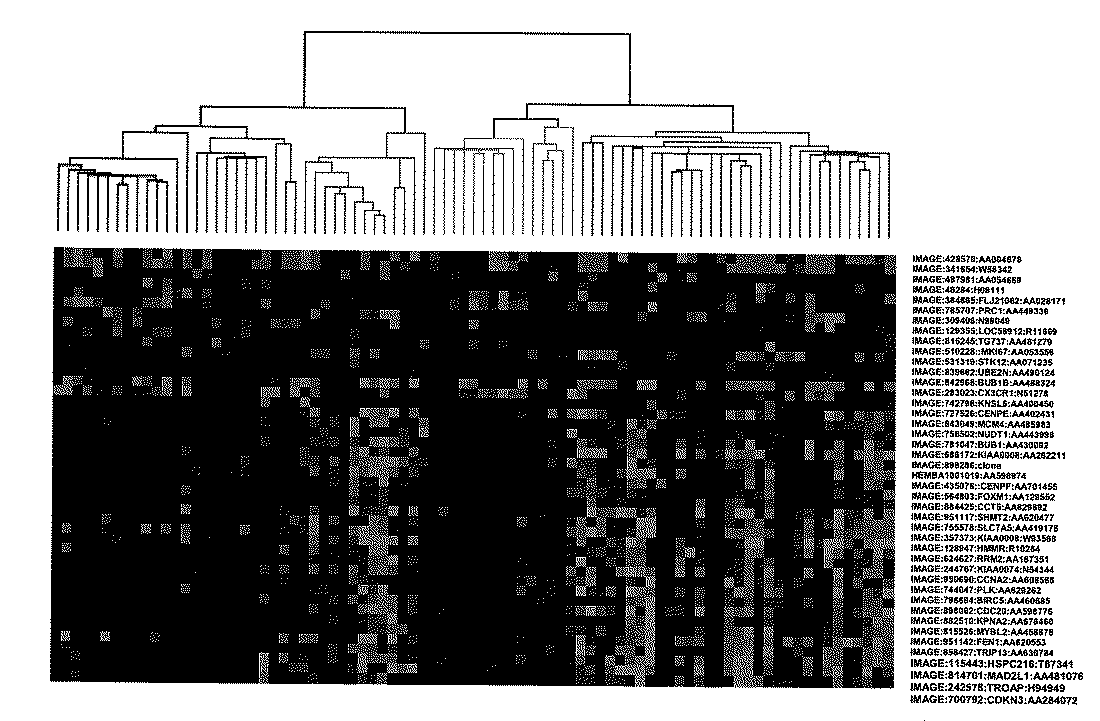Gene-based algorithmic cancer prognosis
a gene-based algorithm and cancer prognosis technology, applied in the field of new methods and tools for improving cancer prognosis, can solve the problems of not allowing “individualization” of cancer patients' care, exposing many women to unnecessary and potentially toxic treatment, and poor reproducibility across institutions
- Summary
- Abstract
- Description
- Claims
- Application Information
AI Technical Summary
Benefits of technology
Problems solved by technology
Method used
Image
Examples
example 1
Material and Methods for Development of Grade Index (GGI) Patient Demographics
[0064]Six datasets of primary breast cancer were used, four of which were publicly available (Table 11) (4, 5, 10, 11). No patient received adjuvant chemotherapy and some had received adjuvant tamoxifen treatment. Histological grade (HG) was based on the Elston-Ellis grading system. Each institutional ethics board approved the use of the tissue material.
TABLE 1Microarray datasets used in this studyMicroarraySystemicIdentifierInstitutionNPlatformTreatmentReference1.Training setKarolinska24Affymetrixyesthis paper(KJX64)John Radcliffe40U133A(tamoxifenonly)2.Validation setKarolinska68AffymetrixNothis paper(KJ129)John Radcliffe61U133A3.Sotiriou et al.John Radcliffe99cDNAYes10(NCI)(NCI)4.Sorlie et al.Stanford80cDNAYes11(STNO)(Stanford)5.van't Veer et al.Netherlands97AgilentNo 4(NKI)Cancer Institute6.Van de Vijver etNetherlands295 AgilentNo 5al.Cancer Institute[61(NKI2)alsoin 5)]Total703
[0065]The samples from Oxf...
example 2
Consistent Prognostic Value of GG in Different Populations and Microarray Platforms
[0091]The results of the pooled analysis above were consistently present in the individual datasets, as shown by the forest plot of hazard ratios in FIG. 4. More complete results are shown in FIG. 8. FIG. 4 shows that in each independent validation dataset, GG divided the grade 2 populations into two distinct groups with statistically different clinical outcomes. There was no significant heterogeneity between the hazard ratios, even though the different datasets included heterogeneous patient populations, were graded by various pathologists and used different micro-array platforms.
Relationship with the 70-Gene Signature
[0092]In their pioneering work, van't Veer et al. identified a 70-gene expression signature significantly correlated with distant metastasis in node negative breast cancer patients (5). The present list of 97 genes (128 probe sets) could be mapped to 93 genes (113 probes) in their Agile...
example 3
Definition of Clinically Distinct Subtypes within Estrogen Receptor Positive Breast Carcinoma
Materials and Methods
Tumor Samples
[0100]Three hundred and thirty five early-stage breast carcinoma samples comprised our own dataset. Eighty-six of these samples have been previously used in another study and the raw data are available at the Gee Expression Omnibus repository database (http: / / www.ncbi.nlm.nih.gov / geo), with accession code GSE2990. These samples had received no adjuvant systemic therapy. Two hundred and forty-nine samples, previously unpublished, had received adjuvant tamoxifen only (tam-treated dataset). All samples were required to be ER-positive by protein ligand binding assay.
[0101]Microarray analysis was performed with Affymetrix™ U113A Genechips® (Affymetrix, Santa Clara, Calif.). This dataset contained samples from the John Radcliffe Hospital, Oxford, U.K., Guys Hospital, London, U.K. and Uppsala University Hospital, Uppsala, Sweden. Samples from Oxford and London were...
PUM
| Property | Measurement | Unit |
|---|---|---|
| real time | aaaaa | aaaaa |
| real time PCR | aaaaa | aaaaa |
| weight | aaaaa | aaaaa |
Abstract
Description
Claims
Application Information
 Login to View More
Login to View More - R&D
- Intellectual Property
- Life Sciences
- Materials
- Tech Scout
- Unparalleled Data Quality
- Higher Quality Content
- 60% Fewer Hallucinations
Browse by: Latest US Patents, China's latest patents, Technical Efficacy Thesaurus, Application Domain, Technology Topic, Popular Technical Reports.
© 2025 PatSnap. All rights reserved.Legal|Privacy policy|Modern Slavery Act Transparency Statement|Sitemap|About US| Contact US: help@patsnap.com

